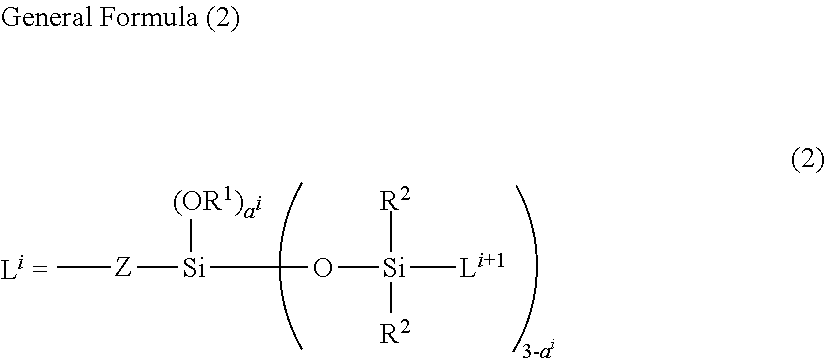Novel Co-Modified Organopolysiloxane
a technology of organopolysiloxane and co-modified polysaccharides, which is applied in the direction of biocide, body powder, make-up, etc., can solve the problems of low compatibility between the remaining polyhydric alcohol derivative and the copolymer that is a reaction product, and the degree of freedom of structural design of the modified silicon, etc., to achieve the effect of stably emulsifying various oil agents, high degree of freedom, and high degree of utility
- Summary
- Abstract
- Description
- Claims
- Application Information
AI Technical Summary
Benefits of technology
Problems solved by technology
Method used
Image
Examples
example 1
Practical Example 1
Synthesis of Silicone Compound No. 1
[0380]194.5 g of a methylhydrogenpolysiloxane expressed by the average composition formula MD400DH10M, 18.8 g of a vinyl tris(trimethylsiloxy)silane expressed by the average composition formula CH2═CH—Si(OSiMe3)3, 3.3 g of a glycerin monoallyl ether expressed by the structural formula CH2═CH—CH2—OCH2CH(OH)CH2OH, and 90 g of isopropyl alcohol (IPA) were placed in a reaction vessel, and heated to 50° C. while agitating under a nitrogen stream. 0.055 g of an IPA solution of a platinum-1,3-divinyl-1,1,3,3-tetramethyldisiloxane complex (Pt concentration: 4.5 wt. %) was added and the mixture was reacted for 2.5 hours at 80° C. Then, 2 g of the reaction liquid was sampled and it was confirmed that the reaction was complete through an alkali decomposition gas generation method (the remaining Si—H groups were decomposed using a KOH ethanol / water solution, and the reaction rate was calculated from the volume of the generated hydrogen gas)...
example 2
Practical Example 2
Synthesis of Silicone Compound No. 2
[0383]196.6 g of a methylhydrogenpolysiloxane expressed by the average composition formula MD400DH10M, 13.6 g of a vinyl tris(trimethylsiloxy)silane expressed by the average composition formula CH2═CH—Si(OSiMe3)3, 5.5 g of a glycerin monoallyl ether expressed by the structural formula CH2═CH—CH2—OCH2CH(OH)CH2OH, and 90 g of IPA were placed in a reaction vessel, and heated to 70° C. while agitating under a nitrogen stream. 0.060 g of an IPA solution of a platinum-1,3-divinyl-1,1,3,3-tetramethyldisiloxane complex (Pt concentration: 4.5 wt. %) was added and the mixture was reacted for 5 hours at 80° C. Then, 2 g of the reaction liquid was sampled and it was confirmed that the reaction was complete through an alkali decomposition gas generation method. The reaction liquid was heated under reduced pressure to remove low-boiling components by distillation. Thus, a novel glycerin-modified silicone having a siloxane dendron structure ex...
example 3
Practical Example 3
Synthesis of Silicone Compound No. 3
[0386]198.8 g of a methylhydrogenpolysiloxane expressed by the average composition formula MD400D1110M, 8.2 g of a vinyl tris(trimethylsiloxy)silane expressed by the average composition formula CH2═CH—Si(OSiMe3)3, 7.9 g of a glycerin monoallyl ether expressed by the structural formula CH2═CH—CH2—OCH2CH(OH)CH2OH, and 90 g of IPA were placed in a reaction vessel, and heated to 70° C. while agitating under a nitrogen stream. 0.060 g of an IPA solution of a platinum-1,3-divinyl-1,1,3,3-tetramethyldisiloxane complex (Pt concentration: 4.5 wt. %) was added and the mixture was reacted for 5 hours at 80° C. Then, 2 g of the reaction liquid was sampled and it was confirmed that the reaction was complete through an alkali decomposition gas generation method. The reaction liquid was heated under reduced pressure to remove low-boiling components by distillation. Thus, a novel glycerin-modified silicone having a siloxane dendron structure ex...
PUM
| Property | Measurement | Unit |
|---|---|---|
| diameter | aaaaa | aaaaa |
| hydrophilic | aaaaa | aaaaa |
| structure | aaaaa | aaaaa |
Abstract
Description
Claims
Application Information
 Login to View More
Login to View More - R&D
- Intellectual Property
- Life Sciences
- Materials
- Tech Scout
- Unparalleled Data Quality
- Higher Quality Content
- 60% Fewer Hallucinations
Browse by: Latest US Patents, China's latest patents, Technical Efficacy Thesaurus, Application Domain, Technology Topic, Popular Technical Reports.
© 2025 PatSnap. All rights reserved.Legal|Privacy policy|Modern Slavery Act Transparency Statement|Sitemap|About US| Contact US: help@patsnap.com



